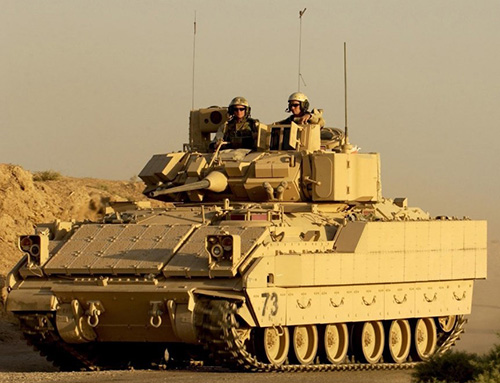The U.S. Army is arming Bradley Fighting Vehicles with heat-seeking Stinger air defense missiles to give the infantry carriers an improved ability to track and destroy enemy air threats such as drones, helicopters and low-flying aircraft.
Most current Bradleys are armed with TOW anti-tank missiles, a land weapon predominantly used for attacking enemy armored vehicles, bunkers or troop formations. Adding Stinger missiles will increase the attack envelope for the vehicles and potentially better enable them to protect maneuvering infantry and mechanized forces in combat.
“As directed by the Chief of Staff of the Army, the Army is conducting a proof of principle to incorporate Man Portable Air Defense Systems back into the Armored Brigade Combat Teams by modifying two dozen Bradleys to carry Stinger Missiles in lieu of TOW Missiles,” Ashley Givens, spokeswoman for Program Executive Officer, Ground Combat Systems, told Warrior Maven.
As anti-armor weapons, TOW missiles are not typically used to attack enemy air threats.
“Current versions are capable of penetrating more than 30 inches of armor, or "any 1990s tank," at a maximum range of more than 3,000 meters. It can be fired by infantrymen using a tripod, as well from vehicles and helicopters, and can launch 3 missiles in 90 seconds,” the Federation of American Scientists writes in a paper.
Stinger missiles, by contrast, are infrared-guided surface-to-air weapons with nearly twice the range as TOW missiles.
Adding Stingers to Bradleys is entirely consistent with the Army’s broad strategic aims for the Bradley, which call for a highly-networked infantry carrier increasingly able to maneuver in support of ground infantry using long-range, high-tech sensors to find and hit targets.
“The Army has chosen to increase the cross-country mobility of the Bradley, allowing it to go further into off-road situations to support infantry formations,” Givens said.
An extended range TOW 2B Aero, engineered with a one-way radio link and range enhancing nose-cap, can hit targets more than four kilometers away; a Stinger missile, however, can reportedly hit targets out to eight kilometers.
Army information says a TOW Bunker Buster warhead consists of a blast type warhead designed to penetrate and then detonate inside Military Operations in Urban Terrain targets such as 8-inch double reinforced concrete, brick-over-block, and triple brick walls. The warhead utilizes both a cast titanium body and chisel style nose to allow better penetration capability while reducing ricochet probability.
The latest TOW upgrade uses Target Acquisition Systems that incorporate Far Target Location capability (ITAS-FTL), a technology which incorporates a global positioning satellite-based position attitude determination subsystem, Army officials said.
An Army paper says ITAS is the fire control system for the TOW missile and consists of integrated optical and second-generation forward-looking infrared sights and an eye-safe laser range finder. It offers improved hit probability by aided target tracking, improved missile flight software algorithms, and an elevation brake to minimize launch transients.






















